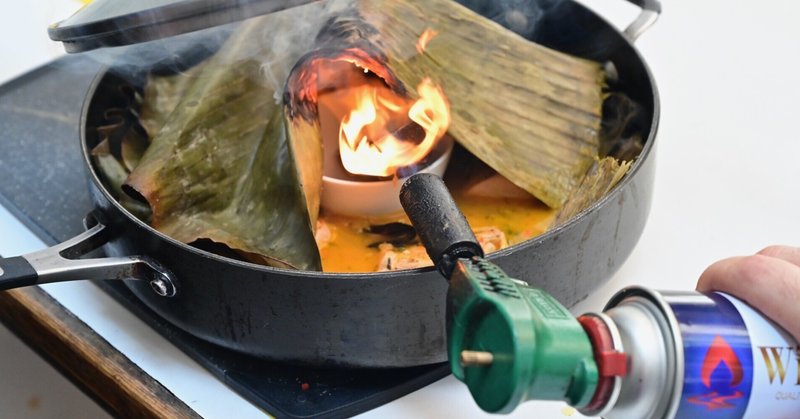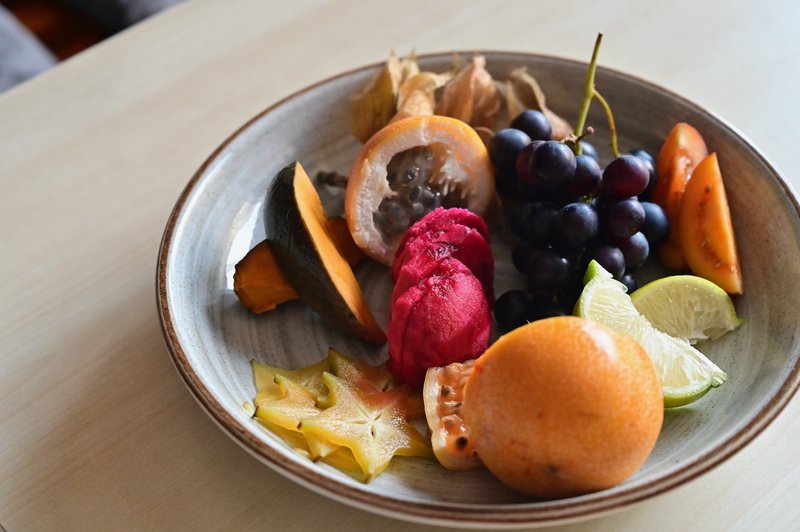
ペルー編10:リマの料理教室でセビーチェを習う
English follows Japanese
Peruvian Cooking Classes
ペルーで連日セビーチェを食べ続けたので、セビーチェの作り方を一度しっかり習いたくなった。そこで2023年2月20日午前中、リマのミラ・フローレス地区にあるクッキングスタジオ「Peruvian Cooking Classes」でプライベート料理教室に参加した。

講師はHector Aguilar valle(エクトル・アギラール・バジェ)氏。彼は18歳でペルーを離れ、中南米諸国からアメリカ、フランス、スペイン、オーストラリアなどの高級レストランで働き、料理の腕を磨いた。そしてペルーに戻り、リマの人気ニッケイレストラン「Maido(マイド)」でシェフを努めた後、「Peruvian Cooking Classes」を開いたそう。
インターネットで彼の経歴を知り、折角ならじっくりと料理を学べるプライベートクラスを申し込んだ。すると、当日のメニューは下記のとおり、温冷2種類のセビーチェを含む7種類もの料理をエクトル本人から直接習えることとなった。
2023年2月20日のプライベート料理教室メニュー
鰹のセビーチェ
鰹のセビーチェ・カリエンテ(温かいセビーチェ)
海老と鶏、2種類のカウサ(マッシュポテト)
アヒ・デ・ガジーナ(鶏肉と黄色唐辛子のパン粥)
トロピカル・フルーツの盛り合わせ
ピスコサワー
パッションフルーツ味のピスコサワー
エクトルは一つの食材やソースを2つ以上の料理に使い分けることも多く、しかも2人では全然食べきれないほど大量に料理を作るので、正確なレシピを書くのは難しい。そこで量はアバウトだが、鰹のセビーチェとセビーチェ・カリエンテ、そして2種類のピスコサワーのレシピを写真とともにお届けしよう。
鰹のセビーチェ
【材料:作りやすい量】
*鰹のサク:500g
*鰹のアラ:300g
*レモン:大量
*紫玉ねぎ:2個
*香菜の葉:1/2カップ
*アヒ・リモ(小さくて辛い赤唐辛子)
*生姜:2かけ
*ニンニク:2かけ
*香菜の茎:少々
*海老の殻:少々
*アカモクに似た海藻:少々
*塩:適宜
*ほんだし粉:小さじ1
*甘く煮たサツマイモのスライス:少々
*塩茹でしたチョクロ(白とうもろこし):少々
*サニーレタス:少々
【作り方】
①レモンを大量に搾る。紫玉ねぎは1個を縦半分に切り、繊維に沿って1mmの細切りにし、塩水にさらす。香菜の葉はみじん切り、アヒ・リモはヘタと種を取り、内側の白い部分を削ぎ落とし、丁寧に2~3mm角のみじん切り。柔らかく煮えたら、室温に冷まし、冷蔵庫で保存する。

②鰹のサクは筋張った部分を切り除き、身を2cmのサイコロ切りにし、塩水に漬ける。

③鍋に鰹のアラと生姜1かけ、ニンニク1かけ、香菜の茎少々、水2カップを入れ、火にかけ、10分煮てから、ザルで漉し、別の鍋に移し、魚のスープを取る。

④スープに海老の殻を加え、1分煮て、殻がピンク色になったら、海老の殻を取り出す。海老の殻とスープをブレンダーにかけ、もう一度ザルで漉す。スープを鍋に戻し、海藻を入れて、火にかける。鮮やかな緑色に変色したら海藻を取り出し、火を止める。海藻は食べる直前まで冷蔵庫で保存する。

⑤スープはレモン汁1カップ、氷1カップ、香菜の茎、ざく切りの紫玉ねぎ1/2個分、生姜1かけ、ニンニク1かけ、アヒ・リモ一切れとともにブレンダーで回し、ザルで濾す。濾したスープを再びブレンダーに入れ、鰹のサクの筋張った部分とほんだし粉を加えて、更にもう一度回す。全体に乳液状になったらレチェ・デ・ティグレの完成。半量をセビーチェ・カリエンテ用に取り分ける。食べる直前まで冷蔵庫で冷やす。


⑥塩水に漬けた鰹を取り出し、水気を拭き取り、ボウルに入れ、塩水にさらした紫玉ねぎのスライス、みじん切りの香菜の葉、みじん切りのアヒ・リモ、レモン汁1/2カップを加え、よく混ぜ合わせる。食べる直前まで冷蔵庫で保存する。

⑦食べる直前に鰹にレチェ・デ・ティグレを注ぎ、混ぜてから、お皿に盛り付ける。サツマイモ、チョクロ、海藻、サニーレタスを並べて完成。

鰹のセビーチェ・カリエンテ
【材料:作りやすい量】
*鰹のサク:500g
*塩:適宜
*ほんだし粉:小さじ1
*味の素:小さじ1
*黒胡椒:適宜
*ロコト(見た目が赤パプリカにそっくりの赤唐辛子):1個
*アヒ・アマリージョ(オレンジ色の唐辛子):5個
*レチェ・デ・ティグレ(上のセビーチェのレシピを参照):1カップ
*レモン汁:適宜
*香菜の葉:1/2カップ
*バナナの葉:適宜
*スモークチップ:適宜
【作り方】
①鰹のサクは7cm✕4cmの大きめのぶつ切りにし、ボウルに入れ、塩、ほんだし粉、味の素、黒胡椒をたっぷりふりかけてまぶす。

②ロコトはガスコンロに直接のせ、直火で焼く。皮が全面真っ黒に焦げるまで焼き、袋に入れて、10分ほど蒸らしてから、皮をむき、ヘタと種を取る。ブレンダーに入れ、少々の水を加えてソース状にする。


③アヒ・アマリージョは種とヘタ、ワタを丁寧に取り除き、鍋に入れ、ひたひたの水を注ぎ、火にかける。沸騰したら、水を捨てる。辛さを和らげるため、3回繰り返し茹でこぼす。皮をむき、ブレンダーに入れ、レモン汁と水を加えて山吹色のソース状にする。

④鍋にロコトのソースとアヒ・アマリージョのソース、取っておいたレチェ・デ・ティグレ、塩、香菜の葉のみじん切り、水を加えて、火にかけ半量まで煮詰める。

⑤フライパンにバナナの葉を敷き、鰹のぶつ切りを並べ、ガスバーナーで表面に焼き色が着くまで炙る。④のソースを回しかけ、フライパンの中央に、バーナーで着火したスモークチップを乗せた小皿を置く。上からバナナの葉を被せた後、フライパンに蓋をして弱火にかけて10分スモークする。



ピスコサワー
【材料:2杯分】

*ピスコ:120cc
*ガムシロップ:40cc
*レモン汁:40cc
*卵白:小1個分
*氷:4~5個
*アンゴスチュラビターズ:少々

【作り方】
①シェイカーにピスコ、ガムシロップ、レモン汁、卵白、氷を入れ、よくシェイクする。グラスに注ぎ、アンゴスチュラビターズを数滴ふりかける。
パッションフルーツ味のピスコサワー
【材料:2杯分】
*ピスコ:80cc
*ガムシロップ:30cc
*パッションフルーツの絞り汁:80cc
*卵白:小1個分
*氷:4~5個
*アンゴスチュラビターズ:少々
【作り方】
①シェイカーにピスコ、ガムシロップ、パッションフルーツの絞り汁、卵白、氷を入れ、よくシェイクする。グラスに注ぎ、アンゴスチュラビターズを数滴ふりかける。

食文化もマジックリアリズム?
出来上がった料理をいただきます!
まずは鰹のセビーチェから。丁寧に複数の出汁を取ったレチェ・デ・ティグレの酸味と旨味が鰹の力強い味を上品に仕上げている。

そしてセビーチェ・カリエンテ(温かいセビーチェ)。火を通した魚の温かいセビーチェは初めていただいた。ほんだしで下味を付けてからスモークした鰹は鰹の藁焼きを思わせる。そこにアヒ・アマリージョとレモンの旨辛いソースが絡み、実に美味い! これは鰹好きの日本人なら一発で大好きになるだろう!

エクトルは海老の殻や鰹のアラなどを使ってしっかり出汁を取るのに、そこに更にほんだしや味の素を加える。これは日本人にとっては奇妙に思える。折角、本物の魚で出汁を取ってるのに、そこにインスタント食品を加えるのはどうなの?と。しかし、南米は現代の日常と神話や魔術の世界が同居する、いわゆる「マジックリアリズム」の世界である。エクトルのこの調理法はそのマジックリアリズムを料理に実践していると思えば合点がいった。「グローバル企業が売り込んでくる商品さえ、我々はいとも簡単に自分たちの文化、そして胃袋に取り込んでしまうのだ!」というペルー人魂?というのは考えすぎか? 元マイドのシェフ、エクトルのペルー料理教室はそんな新しい発見が続いた楽しい4時間料理体験となった。

Peru 10: Learning to Make Ceviche at a Cooking Class


Peruvian Cooking Classes
After enjoying ceviche day after day in Peru, I became eager to properly learn how to make ceviche myself. Thus, on the morning of February 20, 2023, I participated in a private cooking class at the "Peruvian Cooking Classes" studio located in the Miraflores district of Lima.

The instructor, Hector Aguilar Valle, embarked on his culinary journey at the age of 18, leaving Peru to hone his skills in high-end restaurants across Latin America, the United States, France, Spain, and Australia. He later returned to Peru and, after a stint as chef at the popular Nikkei restaurant "Maido" in Lima, he founded "Peruvian Cooking Classes." Intrigued by his impressive resume found online, I opted for a private class to immerse myself in the culinary arts. The day's menu, as planned, included two types of ceviche among seven dishes, all taught directly by Hector himself.
The menu for the private cooking class on February 20, 2023
Bonito Ceviche
Bonito Ceviche Caliente (Warm Ceviche)
Shrimp and Chicken, two types of Causa (Mashed Potato)
Aji de Gallina (Chicken in Yellow Chili Pepper Sauce)
Assorted Tropical Fruits
Pisco Sour
Passion Fruit Pisco Sour
Given Hector's penchant for utilizing one ingredient or sauce in multiple dishes and the copious amount of food prepared, providing precise recipes proves challenging. Hence, approximate quantities for the bonito ceviche, ceviche caliente, and two types of pisco sours will be shared, accompanied by photos.
Bonito Ceviche
Ingredients (for a manageable quantity):
Bonito loin: 500g
Bonito bones: 300g
Lemons: in abundance
Purple onions: 2
Cilantro leaves: 1/2 cup
Aji limo (small and spicy red chili pepper)
Sweet potato: 1/2
Fanta Orange: 1 cup
Choclo (white corn): a bit
Ginger: 2 slices
Garlic: 2 cloves
Cilantro stems: a bit
Shrimp shells: a bit
Seaweed similar to Aka-moku: a bit
Salt: as needed
Hondashi powder: 1 teaspoon
Butter lettuce: a bit
Preparation:
Squeeze a large amount of lemon juice. Slice one onion in half vertically, then into 1mm thin slices following the fibers; soak in saltwater. Chop cilantro leaves finely, and mince Aji limo after removing stems, seeds, and the white inner parts to a 2-3mm dice. Peel the sweet potato, cut into 1.5cm slices, place in a pot, and pour enough Fanta Orange to cover. Cook until tender, then cool to room temperature and store in the refrigerator. Boil choclo in salted water until tender and store in the refrigerator.
Trim sinewy parts from the bonito loin and cut the flesh into 2cm cubes, then soak in saltwater.
In a pot, combine bonito bones, one slice of ginger, one clove of garlic, a bit of cilantro stems, and one cup of water. Bring to a boil for 10 minutes, then strain into another pot to make fish soup.
Blend the soup with one cup of ice, some coriander stems, half a chopped purple onion, one piece of ginger, one piece of garlic, and a slice of Aji limo. Strain, then blend again with the tough parts of the bonito and Hon-dashi powder until it becomes a milky liquid. Leche de Tigre is ready. Keep half for the hot bonito ceviche. Refrigerate until just before serving.
Remove bonito from saltwater, pat dry, and mix in a bowl with saltwater-soaked onion slices, chopped cilantro leaves, minced Aji limo and 1/2cup of Lemon juice. Store in the refrigerator until ready to serve.
Just before serving, pour an appropriate amount of Leche de Tigre over the bonito, mix, and plate. Garnish with seaweed, boiled sweet potato, choclo, and butter lettuce.
Bonito Ceviche Caliente
Ingredients (for a manageable quantity):
Bonito fillet: 500g
Salt: as needed
Hon-dashi powder: 1 teaspoon
MSG: 1 teaspoon
Black pepper: as needed
Rocoto (a red chili pepper resembling red bell pepper): 1
Aji Amarillo (an orange chili pepper): 5
Leche de Tigre (refer to the ceviche recipe): 1 cup
Lemon juice: as needed
Coriander leaves: 1/2 cup
Banana leaves: as needed
Smoke chips: as needed
Preparation:
Cut bonito loin into large 7cm x 4cm chunks, place in a bowl, and season generously with salt, hondashi powder, MSG, and black pepper.
Char the rocoto directly on a gas stove until completely blackened, then steam in a bag for 10 minutes. Peel, deseed, and blend into a sauce with a bit of water.
Remove seeds, stem, and inner fibers from Aji Amarillo, boil thrice to reduce spiciness, peel, and blend into a golden sauce with a bit of water.
Combine the Rocoto sauce, Aji Amarillo sauce, reserved Leche de Tigre, lemon juice, salt, minced coriander leaves, and water in a pot, and reduce to half over heat.
Lay banana leaves in a frying pan, arrange bonito chunks, and sear the surface with a torch until charred. Pour the sauce from step 4 over the bonito, place a small dish with ignited smoke chips in the center, cover with banana leaves, then cover the pan and smoke over low heat for 10 minutes.
Pisco Sour
Ingredients (for 2 servings):
Pisco: 120cc
Gum syrup: 40cc
Lemon juice: 40cc
Egg white: from 1 small egg
Ice: 4-5 cubes
Angostura bitters: a bit
Preparation:
Shake pisco, gum syrup, lemon juice, egg white, and ice well in a shaker. Pour into glasses and add a few drops of Angostura bitters.
Passion Fruit Pisco Sour
Ingredients (for 2 servings):
Pisco: 80cc
Gum syrup: 30cc
Passion fruit juice: 80cc
Egg white: from 1 small egg
Ice: 4-5 cubes
Angostura bitters: a bit
Preparation:
Shake pisco, gum syrup, passion fruit juice, egg white, and ice well in a shaker. Pour into glasses and add a few drops of Angostura bitters.
Is Magic Realism in Food Culture,too?
Let's enjoy the dishes we've prepared!
Starting with the bonito ceviche. The meticulously extracted Leche de Tigre's acidity and umami beautifully elevate the robust flavor of the bonito.
Next, the hot bonito ceviche (Caliente). This was my first time trying a warm ceviche. The bonito, seasoned with Hon-dashi and then smoked, reminded me of straw-grilled bonito. The addition of Aji Amarillo and lemon creates a deliciously spicy and savory sauce. Any bonito lover from Japan would instantly fall for this!
Hector uses shrimp shells and bonito bones to make a rich broth, to which he then adds Hon-dashi and MSG. To a Japanese person, this might seem odd. Why add instant products to a broth made from fresh fish? However, in South America, where contemporary life coexists with myth and magic, known as "magic realism," Hector's cooking method seemed to practice this culinary magic realism. "Even products pushed by global corporations are easily integrated into our culture and stomachs!"—perhaps that's a bit of Peruvian spirit? Or is that overthinking it? Either way, the cooking class with Hector was a fun 4-hour culinary experience full of new discoveries.
この記事が気に入ったらサポートをしてみませんか?
